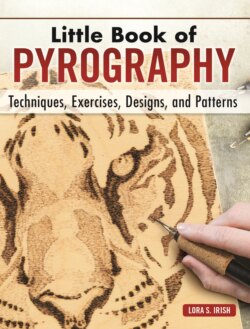Читать книгу Little Book of Pyrography - Lora S. Irish - Страница 10
ОглавлениеGeneral Supplies
You will want to gather a small tool kit of craft supplies for your pyrography. Many of these items are common household items you may already have on hand.
For sanding:
Sandpaper, from 220- to 320-grit
Sanding pads
Foam core fingernail files
Your wood surfaces need a light sanding to create a smooth surface for burning. Use fine-grit sandpaper, 220- to 320-grit, to remove the fine ridges and loose fibers on the wood. Coarse sandpaper, less than 220-grit, can leave sanding lines that can affect the quality of your burn lines. Even fine ridges will cause your tool tip to skip or move as you pull the stroke, resulting in uneven or non-straight lines.
Sanding pads have a foam core and are flexible, making them great for curved surfaces, as on a wood plate or the routed edge of a plaque. Available at your local drug store, foam core fingernail files are a nice addition to your tool kit.
For cleaning tool tips:
Emery cloth or silicon carbide cloth
Fine-steel wool
Leather strop, strop rouge, red oxide or aluminum oxide
It is important to keep your tool tips well cleaned during any burning session to ensure even heat to the tip and consistent color tones to your burning. As you work, notice that the tool tips become dark or dull as carbon from the burning builds up on the wire. The carbon can affect the heat coming from the tip to the wood and leave black carbon smudges on your work. Clean the tips of your tools often.
Scraping the tip with a special tool provided by the manufacturer or with a sharpened knife can quickly clean the tip. Emery cloth, fine-steel wool, or a woodcarving leather strop prepared with either red oxide rouge or aluminum oxide are alternatives.
For tracing:
Pencils
Colored-ink pen
Carbon or graphite paper
Transparent tape
Two products used to transfer the design to your work surface are carbon and graphite papers.
Both products are laid under your paper pattern so that the transfer side is against your work surface. Both should be used carefully, as they are not easily removed from your work surface after burning is complete. Graphite paper, with its soft pale-gray coloring, is especially appropriate for gourds, papier-mâché, and darker woods.
You can also blacken the back of your pattern paper with a soft pencil, covering it completely. Place the pattern onto your work surface and trace over the pattern lines, leaving a fine line of pencil graphite on your work surface. The pencil lines can later be removed with a white artist eraser.
Smooth surface. Sanding wood surfaces before tracing your pattern onto the medium ensures as smooth a working surface as possible. Paper, cloth, and leather do not require sanding.
Cleaning your tips. There are several methods for cleaning the wire tips of the variable-temperature tool.
And generally…
White artist eraser
Transparent tape
Dusting brush
Old toothbrush
Assorted soft paintbrushes
Ceramic tile or wood palette
Rulers and straight edge
T-square or right-angle triangle
Cardboard
Canvas stretchers
Long quilter’s straight pins
Bench knife or utility knife
X-Acto® knife
Small round gouge
Many common household items and tools are used for pyrography to prepare the working surface, secure your pattern, trace the design, and finish the completed burning.
If you will be adding paint to your finished burning, you will need an assortment of soft bristle brushes, a paint palette, water pans, and, of course, the thinning media for whichever type of paint you have chosen to use.
Bench knives or X-Acto® knives can be used to carefully carve away small mistakes in the burning and to cut fine highlight lines into an area that has already been burned. Some pyrographers also use them as scrapers to clean the tool tips.
When working on cotton canvas, you will want several sheets of heavy cardboard and long quilter’s straight pins to secure the cloth so that you are working on a tight, nonmoving surface. Canvas stretchers can be purchased at your local art store so that you can secure large pieces of canvas fabric.
Also include white artist erasers in your kit. Please avoid pink erasers, as they can leave pink streaks of color on your work surface that are not easily removed. The white eraser cleans up any leftover tracing lines and any oil or dirt from your hands that builds up during a burning session.
Large dusting brushes are excellent for removing the dust created during the preparation stage of sanding your wood surface. Old toothbrushes can also be used; they are also useful in removing any excess rouge from your tool tips during preparation.
BASIC SUPPLY LIST:
Single-temperature solid-tip tool
Variable-temperature units
Standard writing tip pen
Micro writing tip pen
Medium or spoon shader tip pen
Sandpaper
Sanding pads, 220- to 320-grit
Foam core fingernail files
Emery cloth or silicon carbide cloth
Fine-steel wool
Leather strop; strop rouge
Pencils
Colored-ink pen
Carbon or graphite paper
Transparent tape
White artist eraser
Dusting brush
Old toothbrush
Assorted soft paintbrushes
Ceramic tile
Rulers and straight edge
T-square or right-angle triangle
Cardboard or chipboard
Canvas stretchers
Long quilter’s straight pins
Bench knife or utility knife
X-Acto® knife
Small, round gouge
Acrylic spray sealer
White glue
Hot glue gun
Fabric paint
Artist colored pencils
Watercolor pencils
